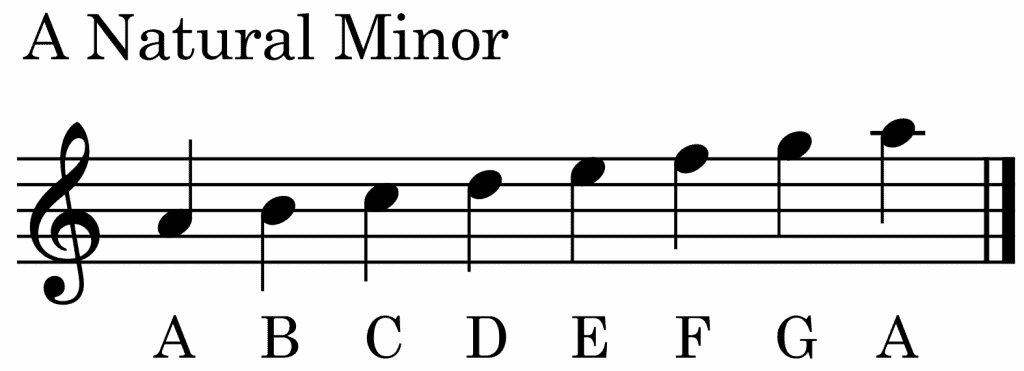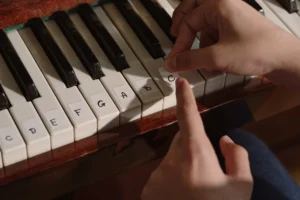Oftentimes music can express those things that we as humans can not say. When musicians write music, they will try and express something that doesn’t quite exist in the real world – a frightening image, a haunting chill, or a difficult memory or unrequited love.
For these moments musicians will often reach for a different complex idea other than major scales. It is here that a musician will use something unique, like a harmonic minor scale.

What is a harmonic minor scale?
The harmonic minor scale is a variation on the minor scale that features a flatted sixth scale degree and a raised seventh scale degree. It has a characteristic “baroque” sound and is quite dramatic and exciting.
Musicians will use a harmonic minor scale formula in order to represent music that feels more complex than just natural minor. The raised seventh scale degree is called a leading tone. This raised note makes this scale very unique sounding, because it is not one of the seven church modes of the major scale, as natural minor is.
Even more so, this means that the other scales separate from the seven modes contain different chords, and different key signatures, which allow your music to sound alien, and represent complexities that are not often found in a minor tonality.
Notes of the harmonic minor scale
Firstly, we start by looking at the A natural minor scale. We notice that the notes of the A minor keys are not actually changed from the key of C major. This is because these two scales are relatives. A natural minor is the relative minor key of C major. We can think about the scale not as a relative minor, but as a singular object that is being derived from the natural minor scale, raising a note up one semitone.
We can also think of this as adding a leading tone, which is the name given to the seventh scale degree being one half step away from the first degree. Remember that harmonic minor is different from melodic minor scales. A melodic minor scale will actually alter the sixth and seventh scale degree on the way up, and a descending melodic minor scale will lower scale degree 6 and 7.
The harmonic minor scale degrees

Then we transform our simple natural minor scales, by changing one scale degree. In order to create harmonic minor scales, we alter the seventh degree by raising it one half step, but we keep all other scale degrees the same. The only difference between these two notes is that the 7th scale degree is raised up by one half step, but we keep all the following notes the same.

Notice how the G♯ is raised in both the ascending form, and descending form. This makes it different from minor keys, because the scales have a different relationship of notes than any natural key. The difference here is that since the 7th scale degree is raised, the space between scale degrees 6 and 7 is not a whole tone, it is called an augmented second – or one three half steps. The extra half steps make the music sound eerie, and confusing – like drifting through space.
Natural minor vs. harmonic minor: what’s the difference?
The biggest difference we get in comparing natural minor and harmonic minor scales come in the form of their unique chord progressions and chord qualities. Because of the raised scale degree, now we have a key where the chords included are actually going to include augmented triads, chord qualities that are left out of typical chord progressions based entirely off of major scales.
Natural minor scales align with major key signatures
If we pay attention closely the notes of our A Minor Scale will actually line up perfectly with the notes of the C major scale. The difference of course is that even though we have the same notes:
C D E F G A B C
We are actually starting on the 6th scale degree in the key of A Minor but the rest of the notes are exactly the same.
A B C D E F G
Because the piano notes are the same in a natural minor scale and a major scale, we are then able to say that the chords and notes that are derived from each are the same, just in a different order. This means then that also we can think about major and minor scales as being connected to one another, or being relatives to one another.
This is not true when we use other types of minor scales, such as harmonic or melodic minor. Then all of a sudden the chords and scales we are employing as part of the key are very different, and we have to understand what they are, how they are different, and how we can use them.
The chords of natural minor
If we use music theory to analyze the piano chords that are included in a natural minor scale, we can arrive at this. The same chords of a major scale, but in a slightly different order since we are starting on the relative sixth degree of a major scale, the “relative minor”.

The chords of harmonic minor
Because of our raised seventh scale degree, our key signature will not reflect the difference in the chords, because there is no key signature for a harmonic minor scale piano. Instead, we have to realize that the chords will be other chords than are typical to each key, because of our raised seventh degree. The sound will be very different, but apart from the 7th, it will use the same notes as natural minor.
Here is A harmonic minor:

Notice that now we have all types of different chords. Our first difference is that C major chord has become a C augmented triad, because of our G♯. An augmented triad has two major thirds to create the chord, which is not the same way we usually spell a major chord. Make sure to recognize the sound, because it is instantly recognizable.
The second big difference is that our 5th chord, E minor when in a natural minor scale has now been transformed into an E major chord. This is a very important chord to recognize that has changed, as now we have a major V chord with G♯, instead of G natural.
The last difference is of course our chord built on the leading tone, or seventh scale degree. This mirrors the chords of our major scale, and now the chord built on the leading tone is diminished.
Notating other harmonic minor scales
Each key has relative major and minor keys, and while we often talk about complex types of major and minor scales, it is important for us to list all of the different notes in each harmonic minor scale. We start by looking at each harmonic minor scale for every white key on the piano. Keep in mind every key has a flat third scale degree, and a raised seventh leading tone.
G harmonic minor scale
The G harmonic minor scale uses a B♭, E♭ and an F♯.

D harmonic minor scale
The D harmonic minor scale uses F natural, B♭, and C♯.

C harmonic minor scale
The C harmonic minor scale uses E♭, A♭ and B natural.

A harmonic minor scale
The A harmonic minor scale uses C natural, F natural, and G♯.

B harmonic minor scale
The B harmonic minor scale uses A♯, F♯, and G natural.

E harmonic minor scale
The E harmonic minor scale uses F♯ and D♯.

F harmonic minor scale
The F harmonic minor scale uses A♭, B♭, and E natural.

How to use the harmonic minor scale
The harmonic minor scale is actually very commonly used in many different types of music. A very famous example of course is the piano classic Für Elise by Ludwig Van Beethoven. When the music shifts into the left hand chord E Major from starting on an A Minor, we have raised the 7th scale degree or leading tone of the scale, and then we have arrived at our harmonic minor.
We can tell this is happening of course with our ears, but also when you look at the music through the Skoove teaching app, you can play the chords and melody along together and see for yourself how the G♯’s are raised in the left hand arpeggios in order to make the chords major. Another famously useful place to find harmonic minor scales is within the minor blues scale.
Final words
Harmonic minor scales are an important part of learning how to play in minor keys. When you play in a minor key there are almost always alterations of the leading tone to make the dominant chord major, as discussed. This skill is so common and occurs in pieces of music from all over the world, and in time.
Many songs use the harmonic minor scale and it is a big topic of learning to play piano. The best place to learn how to recognize all of your different types of harmonic minor scales, or recognizing the difference between all the note names in any key signature is with the Skoove free trial.
Author of this blog post:

Eddie Bond is a multi-instrumentalist performer, composer, and music instructor currently based in Seattle, Washington USA. He has performed extensively in the US, Canada, Argentina, and China, released over 40 albums, and has over a decade experience working with music students of all ages and ability levels.














